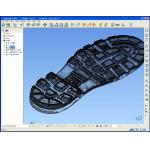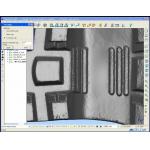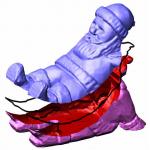Latest News
June 1, 2006
By Al Dean
Delcam is best known for its work in the machining software market. For those that can remember back to the days of DUCT, through the transition to the Windows platform, and the eventual release of the Power Solutions applications range, Delcam has been synonymous with one thing—advanced machining and NC programming. Alongside this, the company has expanded its range of applications outside of CAD/CAM, and the Power Solutions range now includes systems for inspection, adaptive machining, artistic detailing, and reverse engineering. So, let’s take a look at the latter.
Usable Meshes Out of Point Clouds
As with the majority of reverse engineering applications, you start with either a point cloud or a tessellated mesh data file (see Figure 1, below). These might be in the form of raw text files from the capture device or an STL that’s already been through the hardware’s associated applications. The first few steps provide you with the tools to take that point cloud and turn it into a usable polygon mesh. Here CopyCAD 7’s range of automated tools allows you to not only find gaps or holes, but to patch or fill them in using user-definable tolerance controls. For larger gaps, the system also includes additional manual tools to improve and repair those.
|
|
| CopyCAD 7 from Delcam. |
‹ ‹ Figure 1: The starting point for any CopyCAD project is either a point-cloud read from the digitizing device’s output (as shown here) or from a third-party application.
Next up, you need to trim away any excess areas of scan data to reach the form you want. Moving along the process chain, you now need to dig into the data and locate any areas that need to be repaired, or in terms of geometry and form, adapted for modification. After all reverse engineering isn’t an exact science so any system needs to be able to work with the data you “receive” to create the data you “require.”
Where CopyCAD Is Different
Taking stock of the wide range of reverse engineering products out there, most follow the same prescribed process chain: import scan, register, repair, convert to surfaces—output to CAD. CopyCAD is different. Yes, it has a wealth of mesh to surface building tools, but there’s a hell of a lot more you can do with the model in polygon mesh form. Tools are available to assist smoothing out areas where needed or to reconstruct sharp edges. You can also chop out sections of the model and replace it with more geometry (see Figures 2 and 3, below).
|
|
| CopyCAD 7 from Delcam. |
|
|
| CopyCAD 7 from Delcam. |
Figures 2 and 3: CopyCAD includes tools that allow you to initially chop unwanted areas of geometry (left), then quickly patch them back up using a number of different capping methods (right). Click images to enlarge.
While its workflow is similar to other CAD systems, within CopyCAD, the end result is always a polygon mesh. One feature worth of note here is the ability to flatten out a mesh. Data capture systems aren’t 100% accurate and neither are manufactured items. If your scan data should feature flat areas, this tool allows you to select a portion of mesh and morph it into a flat area.
Alongside these core tools, there are other capabilities that allow you to do more with the mesh. It may be the case that you’re taking a physical mockup or an existing design and readapting it for new purposes—it might be an old design for which data doesn’t exist or a heavily reworked (perhaps engraving) product. It might be a time-worn mold tool that needs remanufacture, but with some modifications to account of erosion of features.
Morphing is an area that Delcam has been developing for some time and while other vendors might have a different take on it, to Delcam morphing means the ability to take a dumb model and adapt it to your requirements (see Figures 4 and 5, below). Perhaps a good example is adapting an existing packaging product, such as a 1-liter bottle, and quickly creating a 1.5-liter variant. It might be to model springback into a stamped component, the application doesn’t matter. It’s used to make changes to a model when you don’t have the master CAD geometry. These tools are now available in CopyCAD and can be used in the same manner to adapt polygon meshes.
|
|
| CopyCAD 7 from Delcam. |
|
|
| CopyCAD 7 from Delcam. |
Figures 4 and 5: The morphing technology within many of Delcam’s products has been integrated into CopyCAD, allowing you to deform polygon mesh data with specific controls and parameters, making the whole process very controlled. Here, the toe section of this sole component has been flattened out—this allows you to take an imperfect manufactured product and adapt it to create a digital model that represents the ideal. Click images to enlarge.
Alongside morphing, Delcam’s Total Modeling technology has seen some integration into CopyCAD. This allows the user to combine all manner of geometry types (surface, solid, polygon mesh, artistic detailing, etc.) into a single model. The benefits are that you can mix and match your geometry types to create the forms you want to manufacture directly.
But at the end of the day, Delcam is all about getting parts into production and CopyCAD has been extended into this direction. First, this sees the ability to add more traditional type of features to the mesh, whether that’s creating offset surfaces and patching them in to create design or engineering features. These tools could also be used to create snap fits, ribs, mounting bosses, or machining stock to a machined part.
Another factor to consider is that while there are basic geometry-building tools within CopyCAD, if you’re looking to do anything approaching complex, you might need to move the data across to Delcam’s PowerSHAPE’s traditional surface and solid modeling tools. Data exchange is seamless and bidirectional, so you can work with the scan data in CopyCAD and transfer it to PowerSHAPE for the addition of extra details.
The same manufacturing focus also lets you take scan data right through to manufacture, from capture through to tooling design. CopyCAD 7 has an expanded set of parting line creation tools with which you can find the optimum split line and create that form with a great deal of control (see Figure 6, at left). It can handle the complex split lines often found in the tooling industry, particularly when dealing with complex geometry in the structural packaging and toy industries to name a few. The split line can then be used as the basis for the creation of basic core and cavity sets.
Solid, No-Nonsense Results
Delcam has a solid reputation in the manufacturing industry for providing design and manufacturing-focused tools that solve critical issues within the average company, whether that’s the need to cut tool-steel more quickly with PowerMILL, handle complex design tasks on third-party data with PowerSHAPE, or to conduct metrological operations using PowerINSPECT. What CopyCAD does is to take this solid, no-nonsense approach and apply it to one of the real bottlenecks that still exists in the product development and manufacturing process—the ability to integrate physical forms into a digital workflow. The data capture devices exist and the software is developing rapidly from a number of vendors, but where Delcam’s offering differentiates itself is the ability to take a scan point cloud, convert it to a polygon mesh, and work with that as the basis for the process to take a product into production. There’s no need to convert it to surfaces, unless you need them—and in many cases, you don’t, so why make life more difficult by creating them?
|
|
| CopyCAD 7 from Delcam. |
› › Figure 6: The parting line/split line generation tools let you carry out a manufacturing critical process on geometry that typically could not hold such features (due to its tessellated nature).
CopyCAD allows you to work with physical data in a very quick, clean, and efficient environment and one which doesn’t enforce a particular workflow or series of tasks on the user—and that’s a very valuable proposition indeed.
Al Dean is Technology Editor of the UK’s leading product development and manufacturing journal, MCAD and is Editor of Prototype, for the rapid prototyping and direct manufacturing industry, both available by clicking here. Send your comments about this article through e-mail by clicking here. Please reference “CopCAD, July 2006” in your message.
Product Information
CopyCAD
Delcam, Inc.
Birminghan, UK
Subscribe to our FREE magazine, FREE email newsletters or both!
Latest News
About the Author
DE’s editors contribute news and new product announcements to Digital Engineering.
Press releases may be sent to them via [email protected].












